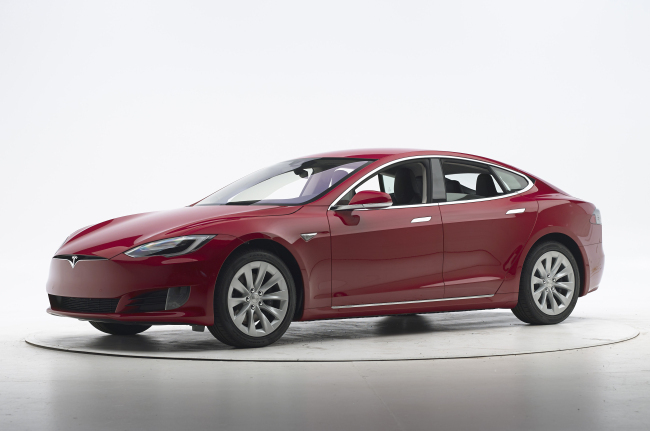[News Focus] Can Tesla still draw drivers despite lack of subsidies?
By Julie Kim JacksonPublished : March 5, 2017 - 15:53
With American electric car giant Tesla preparing to open its first showrooms in Korea next week, industry officials are left speculating whether the company’s high prices and lack of government subsidies will still allow the company to make a big splash in the local eco-car market.
The first model set to hit the local streets will be Tesla’s luxury Model S 90D, with a starting price of 121 million won ($105,000). However, despite the higher price tag compared to competing electric vehicles currently available in the domestic market, Korea customers who purchase Tesla’s Model S will not be eligible to receive government subsidies -- considered to be one of the biggest purchasing appeals of EV cars.
“I think Tesla’s vehicles not being able to receive government subsidies is really going to make a huge difference with local customers,” Kim Pil-su, an automotive engineering professor at Daelim University, told The Korea Herald on Sunday.
“When you also take into consideration that Tesla’s S and X models run more than 100 million won, any type of subsidies would not make a huge difference to its already niche customer base.”
The first model set to hit the local streets will be Tesla’s luxury Model S 90D, with a starting price of 121 million won ($105,000). However, despite the higher price tag compared to competing electric vehicles currently available in the domestic market, Korea customers who purchase Tesla’s Model S will not be eligible to receive government subsidies -- considered to be one of the biggest purchasing appeals of EV cars.
“I think Tesla’s vehicles not being able to receive government subsidies is really going to make a huge difference with local customers,” Kim Pil-su, an automotive engineering professor at Daelim University, told The Korea Herald on Sunday.
“When you also take into consideration that Tesla’s S and X models run more than 100 million won, any type of subsidies would not make a huge difference to its already niche customer base.”

Government subsidies offered to electric car purchasers can receive more than 10 million won in cash-back incentives. However, according to local government standards, electric vehicles that are qualified for cash incentive subsidies must be equipped with battery power that can fully charge in less than 10 hours with a 7-kilowatt-hour, low-speed charger.
The Tesla’s Model S takes at least 14 hours to be fully charged.
Following the Korean debut of the Model S, the company is later expected to release its luxury SUV Model X and the far more affordable Model 3 sedan. At nearly half the price of its flagship S, the Model 3 is likely to have a starting price of $35,000 and is anticipated to be released in Korea sometime next year.
According to Tesla Korea, while the upcoming Model X SUV is not expected to qualify for government incentives, it is anticipated that the Model 3 will meet local standards for subsidies.
“While the Tesla S and X car may be new to Korea, they are not new to the global car market. So it would be difficult to say that Tesla is going to make a substantial boom in the local market straight away,” Kim said.
“However, the Model 3, which has already exceeded 400,000 pre-orders (in the US), has the most potential to make Tesla a real competitor in the Korea electric vehicle market,” he continued. “Not only is this a new model, but it is also much more affordable to a wide range of consumers.”
According to Tesla, the company is planning to set up 25 charging stations throughout the country by this year, with at least six stations to be opened before June.
The American automaker produces the world’s fastest charging stations with the vehicle’s “super charging” capabilities. The stations cut down the S model’s 14-hour charging time to 40 minutes for an 80 percent charge, and 75 minutes for a full charge.
Tesla’s Model S has a driving range of up to 378 kilometers on a single charge -- by far the most among all electric cars currently available in Korea. The carmaker says it has already begun pre-orders and is expected to start delivering cars to customers in June.
Tesla is slated to open its first flagship stores in Korea next week -- one in Hanam, Gyeonggi Province and its second Cheongdam-dong, Seoul on March 15 and 17, respectively.
By Julie Jackson (juliejackson@heraldcorp.com)



![[AtoZ into Korean mind] Humor in Korea: Navigating the line between what's funny and not](http://res.heraldm.com/phpwas/restmb_idxmake.php?idx=644&simg=/content/image/2024/04/22/20240422050642_0.jpg&u=)


![[Herald Interview] Why Toss invited hackers to penetrate its system](http://res.heraldm.com/phpwas/restmb_idxmake.php?idx=644&simg=/content/image/2024/04/22/20240422050569_0.jpg&u=20240422150649)
![[Graphic News] 77% of young Koreans still financially dependent](http://res.heraldm.com/phpwas/restmb_idxmake.php?idx=644&simg=/content/image/2024/04/22/20240422050762_0.gif&u=)

![[Exclusive] Korean military set to ban iPhones over 'security' concerns](http://res.heraldm.com/phpwas/restmb_idxmake.php?idx=644&simg=/content/image/2024/04/23/20240423050599_0.jpg&u=20240423183955)





![[Exclusive] Korean military to ban iPhones over security issues](http://res.heraldm.com/phpwas/restmb_idxmake.php?idx=652&simg=/content/image/2024/04/23/20240423050599_0.jpg&u=20240423183955)



![[Today’s K-pop] Ateez confirms US tour details](http://res.heraldm.com/phpwas/restmb_idxmake.php?idx=642&simg=/content/image/2024/04/23/20240423050700_0.jpg&u=)